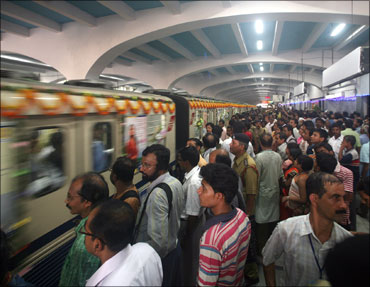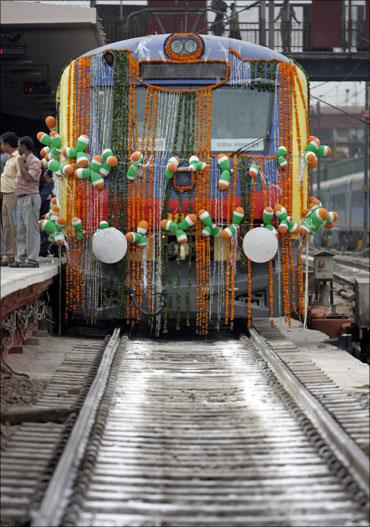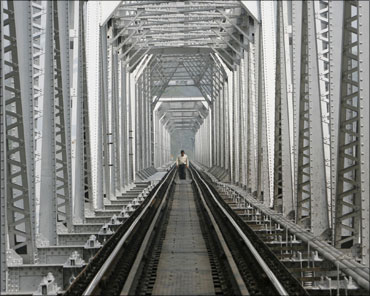
In 2000, the Indian Railways -- the world's second largest railway network under a single management -- was nearly bankrupt. Over the next eight years, however, there was a dramatic improvement in its performance.
From a cash surplus before dividend of Rs 1,071 crore (Rs 10.71 billion) in 2000, it achieved an estimated Rs 25,000 crore (Rs 250 billion) -- or around Rs 13,000 crore (Rs 130 billion) after accounting for all expenditures, receipts and depreciation -- in 2008.
Alongside came a dynamic and differential tariff policy, and technical changes that led to an enhanced carrying capacity.
How all this was accomplished is the focus of this riveting study of change and innovation in the Indian Railways. Authors V Nilakant and S Ramnarayan identify four distinctive features associated with the organisation's renewal between 2004 and 2008 in their seminal work: Changing Tracks: Reinventing The Spirit Of Indian Railways.
Confronting several myths about organisational change, the following excerpt from the book offers powerful lessons for managers grappling with the challenges of generating innovation and improving performance in a changing world.
Click NEXT to find out how was Indian Railways renewed. . .
Excerpt from Changing Tracks: Reinventing The Spirit Of Indian Railways
Authors: V. Nilakant and S. Ramnarayan
Published by Collins Business
An imprint of HarperCollins India
Price: Rs 399; Pages 222
Copyright: Collins Business

The renewal of the Railways came about as a result of three types of changes. First, a commercial mindset was gradually introduced in the organization by replacing the earlier tariff policy with dynamic and differential pricing that was sensitive to market realities and customer needs. This change did not happen overnight but took place over a four-year period.
Second, certain major technical changes were introduced to enhance carrying capacity of wagons and reduce the time taken for loading, unloading and examining trains. These changes also took place step by step over a four-year period.
Third, initiatives were launched to increase interdepartmental collaboration, enhance sensitivity to passenger concerns and improve cleanliness, safety and punctuality of trains. These were the most difficult to implement. This aspect of the renewal is still incomplete.
All three initiatives required changes in the prevalent mindsets. (The then railway minister) Lalu Prasad and (officer on special duty, Indian Railways) Sudhir Kumar were most successful in instilling a commercial orientation in an organization that was largely concerned with 'keeping the wheels moving'.
They were moderately successful in changing mindsets relating to technical aspects - loading, unloading and examining trains. And they were not so successful in altering mindsets relating to interdepartmental collaboration and customer service.
Click NEXT to see how Railways defied conventional wisdom. . .

The Railway's experience with change confounds conventional wisdom on how to manage organizational change. In the West, the term change management has come to signify downsizing, restructuring and cost cutting.
Other popular accounts of change management exhort managers to develop a compelling vision, communicate it relentlessly to the rest of the organization, set up a transition management team, remove barriers to change, go for early wins and institutionalize the changes.
This is not how change happened in the Railways. It was more a process of trial and error, acknowledging mistakes and learning from them, persisting patiently and opting for incremental improvements.
One of the distinctive aspects of managing change was that the people involved in the renewal process did not directly address the weaknesses of the organization. Instead, they leveraged its strengths.
Click NEXT to check out the 4 vital principles for success. . .

Four vital principles for successful renewal
Our research has uncovered four key principles that underlie the phenomenon of the Railways' renewal. The people involved in the change process -- the minister, his advisors and the Railway Board, did not consciously adopt the four principles. But the change was successful because their actions were consistent with these four principles.
Principle 1: Connecting with the soul of the organization
The term soul does not refer to any spiritual aspect of the organization but to its positive core. It represents the essence of an organization when it is at its best. Managers and leaders can discover the soul of an organization by paying attention to its history and context.
They can nurture the soul by respecting an organization's protocols and procedures that reflect its positive core. The positive core of the Railways, not visible to outsiders, is its ability to keep the wheels moving in times of crisis, its willingness to take risks in order to accomplish desirable goals, and the competence and dedication of key staff members to rise to the occasion and meet challenges.
The renewal was successful because the people involved in managing the change tapped into the soul or the positive core.
Click NEXT for the second principle. . .

Principle 2: Fostering Positive Emotions
A large, declining bureaucratic organization such as the Railways fostered apathy, despair and cynicism. One of the prevailing mindsets was, 'nothing will change here.'
Such negative emotions can block change. People who led various change initiatives in the Railways fostered positive emotions by keeping in touch with the staff and constantly expressing faith in their abilities to improve performance. They also communicated enormous belief in their ability to reach the ambitious goals that were set for the organization.
Positive emotions were nurtured by celebrating early successes and by showing gratitude to staff through monetary and non-monetary rewards. People who led the change utilized the pride that employees had for the Railways to inspire them towards better performance.
Positive emotions created a climate for innovation and risk taking. The successful achievement of goals reinforced the positive emotions, creating a virtuous cycle.
Click NEXT for the third principle. . .

Principle 3: Developing Business Savvy
In order to survive, the Railways needed to generate a surplus. The concept of a business model offers a powerful way of analyzing the fundamentals of an organization's performance. A business model tells the manager how the business can make money.
If we accept the premise that business can only generate profits by providing customers with value at an acceptable cost, a business model signifies the underlying economic logic of an organization. In other words, a business model reveals the profit engine that drives a business. This engine is not immediately obvious.
Entrenched mindsets in an organization can prevent its people from identifying its profit engine. These mindsets have to be challenged and discarded. In order to identify a winning business model, managers need to pay attention to cost drivers and revenue streams.
This was a formidable task in the Railways because the organization lacked a commercial orientation. Between 2004 and 2008, however, a commercially oriented mindset or business savvy was developed in the organization by challenging existing mindsets. There was a generation of surplus as a result of paying attention to the business model, costs and revenues.
Click NEXT for the fourth principle. . .

Principle 4: Focusing on Outcomes
Most organizational change efforts fail at the implementation stage. Almost all the ideas that led to the successful renewal of the Railways were already known inside the organization. Some of these ideas had been discussed and debated for decades but never implemented.
The renewal was successful because these old ideas were converted into reality despite formidable barriers to implementation, including people, policies and procedures. A key aspect was the persistence and patience exhibited by people leading the various change initiatives.
They were determined, tenacious and unwilling to give up till the goals were achieved. Not all the change initiatives were successful; some failed rather spectacularly. However, these setbacks and failures did not dampen the enthusiasm and motivation of the people leading the change processes. They were cheerful, humble and extraordinarily relentless in the pursuit of their goals.
The striking thing about the renewal of the Railways is that there is a huge scope for further changes and improvements.
Spectacular as they may seem, the changes so far have barely scratched the surface of the vast potential that lies untapped in the organization - they are only the first stage in a long process of reinventing the Railways. To achieve continued growth, energy and efforts would have to be reinvested.
Excerpt from Changing Tracks: Reinventing The Spirit Of Indian Railways
Authors: V. Nilakant and S. Ramnarayan
Published by Collins Business
An imprint of HarperCollins India
Price: Rs 399; Pages 222
Copyright: Collins Business